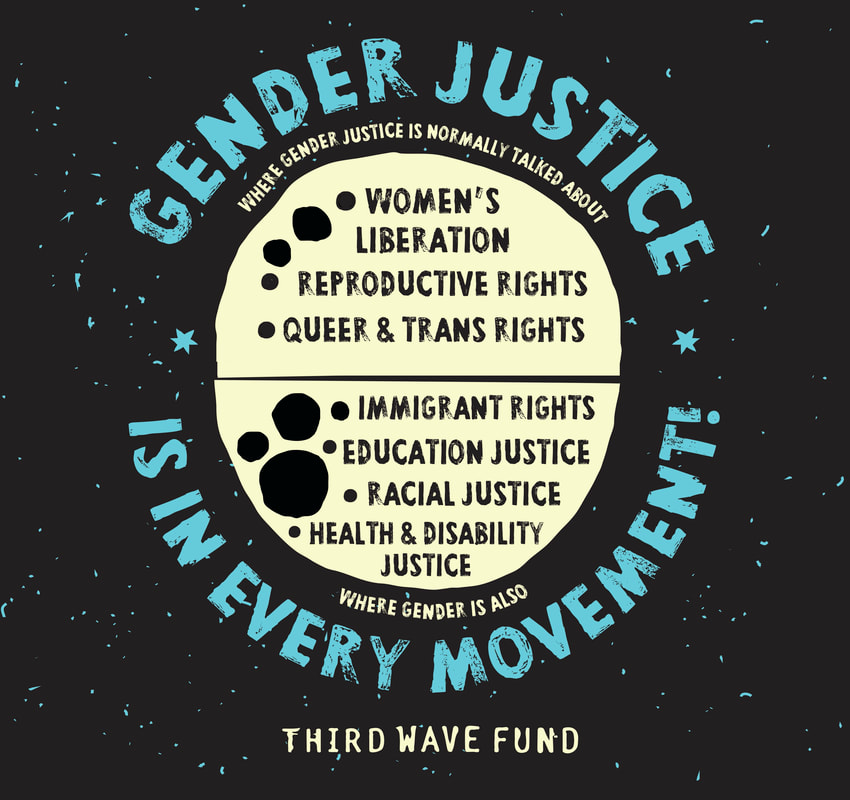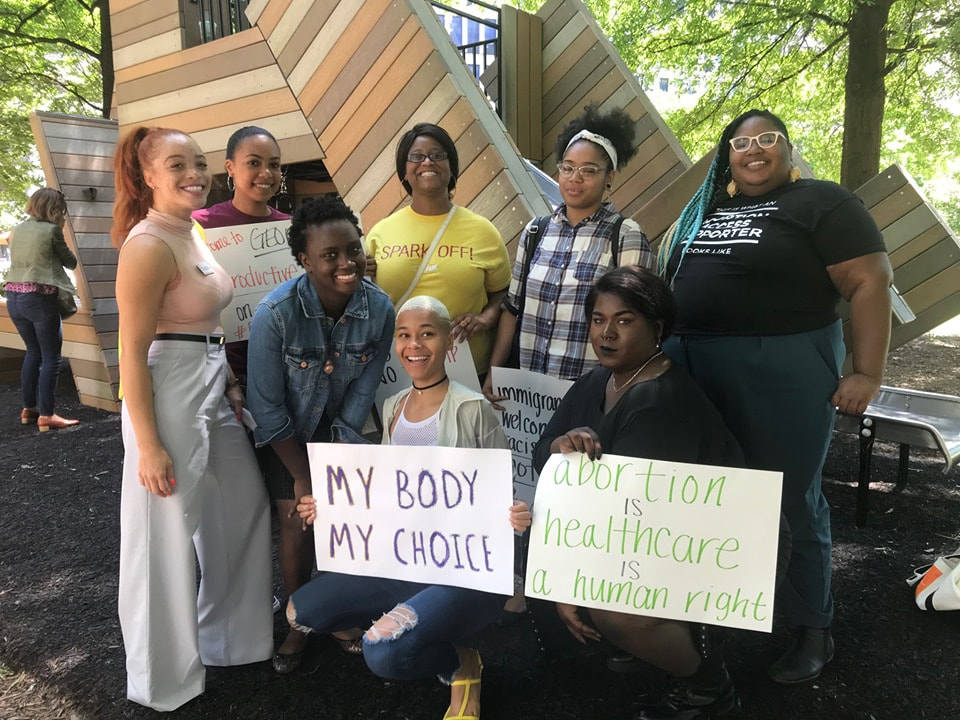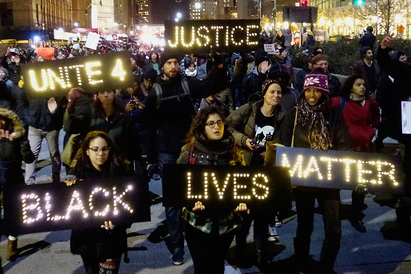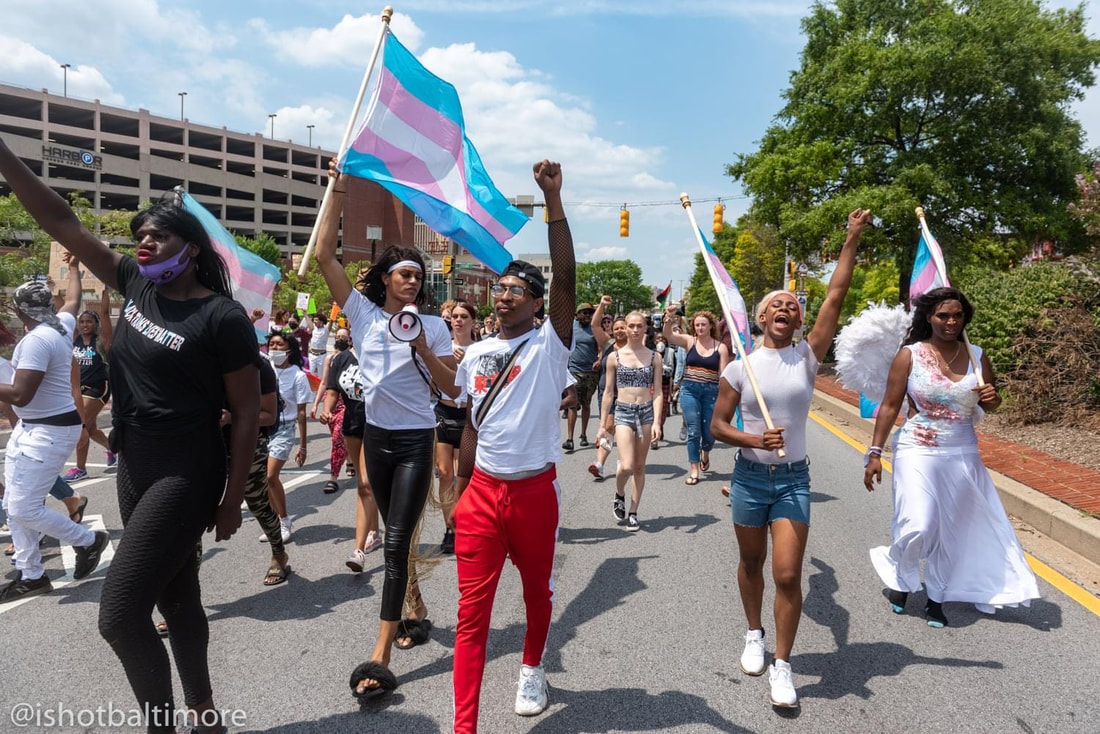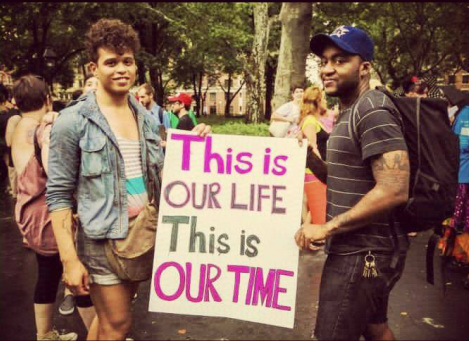What is Gender Justice?
Third Wave defines gender justice as a movement to end patriarchy, transphobia, and homophobia and to create a world free from misogyny. As gender justice activists, we recognize that gender oppression is tied to classism, racism, ageism, and ableism, so gender justice can only truly be achieved when all forms of oppression cease to exist.
|
For Third Wave Fund, Gender Justice Movements are:
MULTI-ISSUE Because gender is connected to all aspects of our lives. COMMUNITY-LED By those who are directly impacted by oppression. FEMINIST, QUEER & TRANS Unapologetically. Gender Justice is in every movement! |
Gender Justice graphic designed by Rommy Torrico.
|
Gender Justice is Reproductive Justice
|
We know gender is at play when it comes to bodily autonomy. SCOTUS is overturning Roe v. Wade and the Right is passing legislation state-by-state to criminalize reproductive health and gender affirming care. These attacks are directly connected to racism, classism, transphobia, misogyny, and patriarchy. Powerful resistance takes place when women of color, trans and queer people, and low-income communities most affected by these issues have the resources to lead, yet consisently have the least access to funding.
Our vision is a world where people of all genders have full autonomy over our own bodies and lives, including access to safe, legal, and affordable abortions, reproductive health, and gender-affirming care. |
Gender Justice is Racial Justice
|
Gender plays a role in movements that aren't often associated with women and girls. Gender plays a crucial role in the #BlackLivesMatter movement, for instance. The violence Black women and girls face is treated as a footnote, and the women of color spearheading the movement have been kept out of many conversations. Gender Justice seeks to reverse the legacy of co-opting the leadership of women of color in histories of resistance by focusing on their leadership and recognizing gender as an important piece of all movements.
|
Gender Justice is Queer & Trans Justice
|
Gender justice isn't just about cisgender, heterosexual women and girls. Violence and oppression often target expressions of femininity, regardless of one's birth sex or gender identity. LGBTQ people, especially transgender women and non-binary, intersex, and gender non-conforming youth, lead and support gender justice activism across a range of issues, including reproductive justice, immigration, prison abolition, anti-violence, and economic security.
|
We Prioritize Access and Lived Equality, NOT JUST Policy Wins
|
Civil rights and legal protections, though critically important, do not inherently end the marginalization of oppressed communities.
That's why Gender Justice is different from Gender Rights. Gender Justice is a response to people's lived experiences of violence and oppression that legal and civil protections alone can't tackle. Gender justice as a framework recognizes the role that state, legal, and economic systems can play in perpetuating gender-based violence and oppression. |
Laws and policies that are meant to support marginalized communities can at times create more oppression and violence. For example, the homicide rate of transgender people in the US is on the rise, and the average lifespan of trans women of color is 35 years old despite existing laws against murder and transgender people's increased legal protections and visibility. There are numerous examples where laws themselves punish individuals for the outcomes of their pregnancies, self-defense against harassment or violence, HIV status, and involvement in the sex trade.
We Center the Leadership of Those Most Impacted
We believe that inclusion cannot be an afterthought, and that our diversity, personal experiences, and voices are our greatest strengths!
Far too often, communities of color, youth, and low-income folks are spoken for, advocated for, and left out of decision-making power.
Powerful outcomes take place when folks most affected by an issue have the space, resources, and support it takes to lead.
Because of this, we support the leadership of communities who are at the center of oppression but find ourselves on the margins of philanthropy. Young women of color, queer and trans youth of color, and low-income folks know what we need best and are highly capable of leadership.
Far too often, communities of color, youth, and low-income folks are spoken for, advocated for, and left out of decision-making power.
Powerful outcomes take place when folks most affected by an issue have the space, resources, and support it takes to lead.
Because of this, we support the leadership of communities who are at the center of oppression but find ourselves on the margins of philanthropy. Young women of color, queer and trans youth of color, and low-income folks know what we need best and are highly capable of leadership.
We Fund Where It Matters Most
"Quite frankly, we would not exist without Third Wave's investment in our vision. Third Wave has supported us fiercely to become the political force we were meant to be in a place where it was thought to be impossible. Because of Third Wave, still we specialize in the wholly impossible.'" – La'Tasha D. Mayes, Executive Director of New Voices Pittsburgh
Third Wave resources youth-led gender justice activism to fill the major national funding gap. Multi-issue work often has few avenues for funding. And, movements led by women of color, trans and queer people, and low income communities are vital to justice and liberation, yet have the least access to funding. These groups are often the last to get funding and the first to lose it when the going gets tough.
National philanthropic support for gender justice is dismal:
Within LGBTQ-focused philanthropy:
(Sources: Funders for LGBTQ Issues and Women Moving Millions)
National philanthropic support for gender justice is dismal:
- Funding for women and girls' issues only accounts for 7% of philanthropic giving, and dollars reaching women and girls of color are not even tracked.
- Funding for work with and for LGBTQ people accounts for 0.24% of all philanthropic giving, and funding for work with and for LGBTQ people of color is only 0.048%.
Within LGBTQ-focused philanthropy:
- Funding for transgender issues made up only 6% of all LGBT giving in 2013, of which less than half went to organizations or projects led by transgender people.
(Sources: Funders for LGBTQ Issues and Women Moving Millions)

